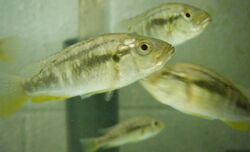Biology:Astatotilapia calliptera
| Astatotilapia calliptera | |
|---|---|

| |

| |
| Male above, females below, all of Lake Chilingali origin | |
| Scientific classification | |
| Domain: | Eukaryota |
| Kingdom: | Animalia |
| Phylum: | Chordata |
| Class: | Actinopterygii |
| Order: | Cichliformes |
| Family: | Cichlidae |
| Genus: | Astatotilapia |
| Species: | A. calliptera
|
| Binomial name | |
| Astatotilapia calliptera (Günther, 1894)[2]
| |
| Synonyms | |
| |
Astatotilapia calliptera, the eastern happy or eastern river bream, is a species of haplochromine cichlid from southeastern Africa.
Description
The male Astatotilapia calliptera has blue lips and a dark line through its eye. It can show a reddish forehead but the body is normally yellow, although some wild populations are blue.[3] The females are smaller than the males and are brownish silvery in colour.[4] The maximum total length is 15 cm (5.9 in).[5]
Distribution
Astatotilapia calliptera occurs in Lake Malawi and its drainage, the Shire River, and Lakes Chiuta and Chilwa. It has also been recorded from the lower Zambezi River,[5] and in coastal rivers on the coastal plain of Mozambique, from the Rovuma River and south as far as the Save River,[1] This species is established as a non-native, introduced species in Broward County and Palm Beach County in Florida, United States.[6]
Habitat and ecology
Astatotilapia calliptera prefers shallow water with a sand substrate with aquatic vegetation such as species of Vallisneria,[3] where it can be abundant. It is most common in the lower reaches of rivers and weedy flood lagoons.[1] It is an omnivore and much of its diet consists of detritus and phytoplankton;[3] they will also eat invertebrates, algae and smaller fishes.[5]
They are mouthbrooders in which the female lays her eggs on a hard substrate and then they are inseminated by the male before the female takes them into her mouth where they stay for 12-14 days before hatching. The young are then guarded by their mother for a further 5-6 days, using her mouth as a refuge when they perceive danger.[5]
Aquarium trade
Astatotilapia calliptera was one of the first cichlid species found in the aquarium trade.[4][7] A number of colour varieties are available.[4]
References
- ↑ 1.0 1.1 1.2 Tweddle, D.; Bills, R.; Kazembe, J.; Marshall, B. (2018). "Astatotilapia calliptera". IUCN Red List of Threatened Species 2018: e.T181801A99449839. doi:10.2305/IUCN.UK.2018-2.RLTS.T181801A99449839.en. https://www.iucnredlist.org/species/181801/99449839. Retrieved 19 November 2021.
- ↑ Eschmeyer, William N.; Fricke, Ron; van der Laan, Richard, eds. "Astatotilapia calliptera". California Academy of Sciences. http://researcharchive.calacademy.org/research/ichthyology/catalog/fishcatget.asp?spid=37742.
- ↑ 3.0 3.1 3.2 "Astatotilapia calliptera". African-cichlid.com. http://www.african-cichlid.com/Calliptera.htm.
- ↑ 4.0 4.1 4.2 "Astatotilapia calliptera". Greater Chicago Cichlid Association. http://www.gcca.net/malawi-cichlid-profiles-list/26-astatotilapia-calliptera#.W_72OfZ2sbo.
- ↑ 5.0 5.1 5.2 5.3 Froese, Rainer and Pauly, Daniel, eds. (2018). "Astatotilapia calliptera" in FishBase. June 2018 version.
- ↑ Jason Seltz (28 April 2017). "Florida's Introduced Nonindigenous and Invasive Fishes: Part 1 of a 3-part Series on Biological Invasions in Florida". Anamar Environmental Consulting Inc.. http://www.anamarinc.com/blog-frontpage/entry/florida-s-introduced-nonindigenous-and-invasive-fishes-part-1-of-a-3-part-series-on-biological-invasions-in-florida.
- ↑ Greg Steeves. "Astatotilapia calliptera". The Cichlid Forum. https://www.cichlid-forum.com/articles/asta_calliptera.php.
Wikidata ☰ {{{from}}} entry
 |


